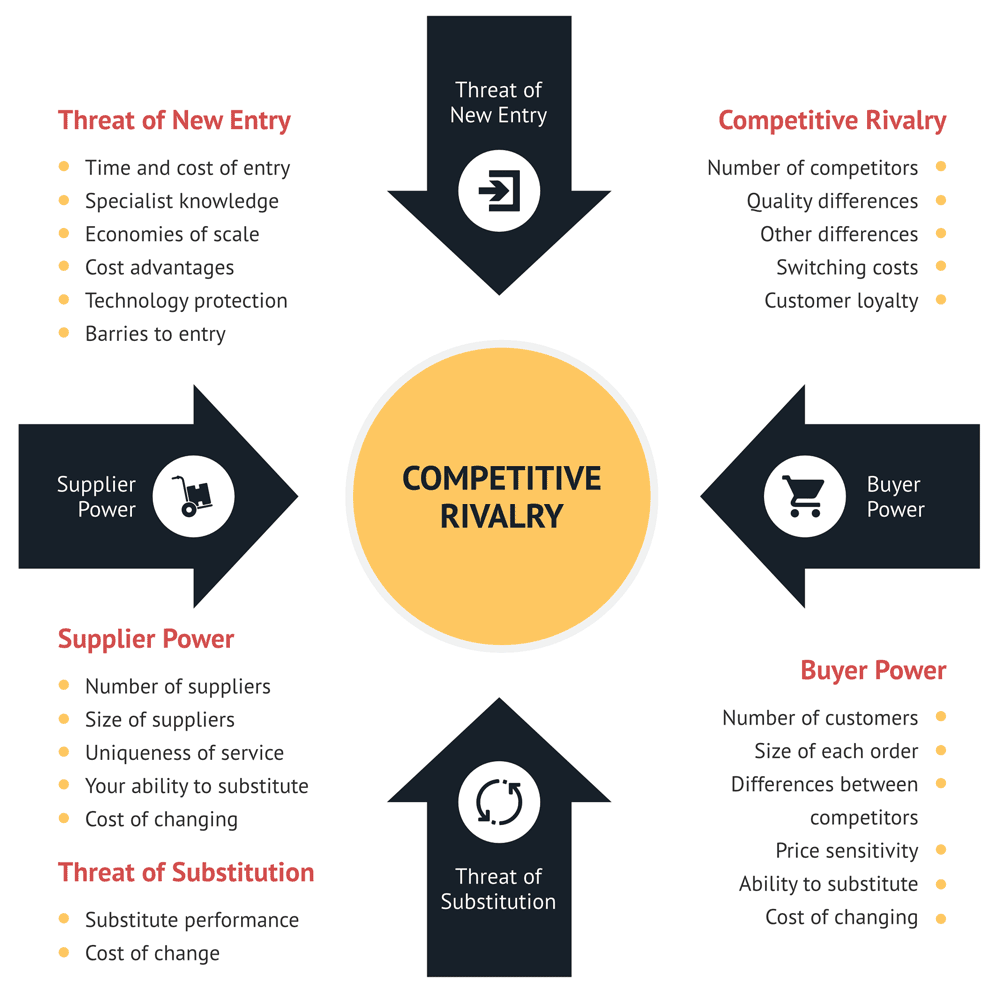Five Forces Analysis
(2025-08-16T22:22.862Z)
Perplexity Query
(2025-08-16T22:22
.862Z)
Question:
Write a comprehensive one-page article about "Five Forces Analysis".
Response from sonar-pro:
Porter's Five Forces Analysis is a powerful framework designed to assess the competitive environment and profitability potential of industries. Developed by Harvard professor Michael E. Porter in 1979, the model enables organizations to systematically examine the core factors influencing competition and strategic decision-making.
[e194sk]
[0gowue]
Understanding these forces is crucial for businesses seeking sustainable growth and competitive advantage, particularly in today’s rapidly changing markets.
[ds6sp1]

The Five Forces Analysis Framework
Porter's Five Forces Analysis consists of five key competitive factors:
- Threat of New Entrants
- Threat of Substitute Products or Services
- Bargaining Power of Buyers
- Bargaining Power of Suppliers
- Rivalry Among Existing Competitors
Each force shapes the competitive intensity and market attractiveness:
- Threat of New Entrants describes how easy it is for new companies to enter the market; high barriers (such as patents or capital requirements) discourage entry and protect incumbents.
- Threat of Substitutes refers to the availability of alternatives that consumers may switch to, impacting demand and pricing power.
- Bargaining Power of Buyers is strong when customers have many options or buy in large volumes, allowing them to demand lower prices or higher quality.
- Bargaining Power of Suppliers becomes significant when a few suppliers control critical resources, enabling them to dictate prices or terms.
Practical Examples and Use Cases
Business leaders use Five Forces Analysis in diverse scenarios:
- Market Entry: A tech startup assessing entry into the smartphone market may find intense rivalry and high supplier power, indicating substantial hurdles.
- Mergers & Acquisitions: An energy conglomerate might evaluate the target industry’s partner and customer power before investing.
Researchers and consultants use tools like IBISWorld reports to map industries and apply Five Forces for tailored insights on profitability and risk.
[plm448]
Benefits and Applications
Key benefits include:
- Structured industry analysis: Provides a clear method for dissecting market dynamics.
- Strategic decision support: Informs expansion, product development, and responses to market disruptions.
The model is widely used in MBA programs, executive planning, and by consulting firms for both qualitative and quantitative strategic evaluations.
Challenges and Considerations
While the Five Forces framework is robust, it is not foolproof. Limitations include:
- Its static nature may not capture rapid technological disruptions.
- Heavy reliance on industry-level data can overlook niche market dynamics or specific organizational strengths.

Current State and Trends
Porter's Five Forces remains foundational in strategic management, especially for industries facing digital disruption and globalization. Leading companies and consultancies regularly adopt it to inform repositioning and innovations. The rise of digital platforms and global supply chains has led to new configurations for each force, such as increased bargaining power for buyers via online price comparison or new entrants disturbing established markets with novel business models.
[0gowue]
[ds6sp1]
[6edqy8]
Recent developments include:
- Enhanced data analytics tools for more dynamic and granular Five Forces evaluations.
- Adoption by major research providers, like IBISWorld, enabling sector-specific and global assessments for thousands of industries. [plm448]
- Integration into digital credential systems, allowing professionals to demonstrate strategic analysis skills on platforms like CredBadge™. [ds6sp1]

Future Outlook
The Five Forces framework will likely evolve with advancements in digital analytics, AI-driven decision support, and increasing market complexity. Future applications may focus on real-time competitive analysis and integration with ESG (Environmental, Social, Governance) criteria, deepening insights for sustainable strategy. The impact will be most profound in industries where transformation—driven by technology or new regulations—reshapes traditional competitive boundaries.
[ds6sp1]
Porter's Five Forces Analysis remains a vital tool for understanding competition, guiding strategic choices, and anticipating market changes. As business environments become more volatile, mastering this framework will be essential for shaping successful, future-ready organizations.
Citations
[e194sk] 2025, Jul 27. Porter's five forces analysis - Wikipedia. Published: 2003-06-26 | Updated: 2025-07-27
[0gowue] 2025, Jun 19. Porter's 5 Forces Framework: Explanation & Uses. Published: 2022-10-10 | Updated: 2025-06-19
[plm448] 2024, Aug 13. Porter's Five Forces - BUS 225 - Critical Business Skills for Success. Updated: 2024-08-13
[ds6sp1] 2025, Aug 16. Porter's Five Forces: The Ultimate Competitive Strategy Blueprint | TSI. Published: 2024-04-19 | Updated: 2025-08-16
[6edqy8] 2025, Jul 09.
. Published: 2021-09-29 | Updated: 2025-07-09